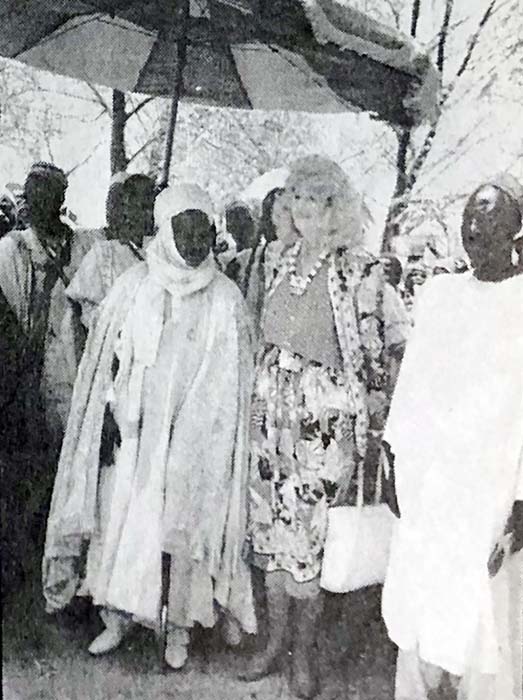Hermiston History: Former U.S. ambassador retires to local family ranch
Published 6:00 am Wednesday, March 8, 2023

- Harriet Isom, a former U.S. ambassador and career diplomat, is pictured in this undated photo with Cameroonian chiefs and locals in Africa.
25 YEARS AGO
March 10, 1998
Harriet Isom, a retired U.S. ambassador and career diplomat, was not the typical country woman. Born in Heppner and raised on a family ranch in Echo, Isom attended Pendleton High School.
After earning a master of arts in international law and diplomacy from Fletcher School of Law and Diplomacy, in Massachusetts, she began her political career in 1961 by working for the Department of State in Washington, D.C. Soon, she found herself in U.S. embassies in Malaysia, Indonesia, Niger and Burundi. Some of her career highlights included earning the title of “Permanent Charge D’Affaires” as head of the American Embassy in Vientiane, Laos, and watching Benin of West Africa transform from a Marxist military dictatorship into a democracy.
Though diplomacy entailed much negotiating, speeches and meetings, Isom still got her fair share of action. In 1970, she survived a coup d’etat, adding, “We were confined to our houses for three days. From the hill where I lived, I could see the tanks and the fighting.”
Upon retiring, the 61-year-old Isom returned to the family ranch with 36 years worth of amazing stories from foreign lands.
50 YEARS AGO
March 8, 1973
It turned out that concerns about Hermiston Junior High students crossing North First Street were justified.
Rick Sturgeon, a ninth grader, was hit by a truck while in the crosswalk returning from Dairy Queen. He was taken to the Good Shepherd Hospital.
School officials said that was the first accident to occur involving school children in the North First Street area. While frightening, they claimed such risk would be greatly reduced in the following year.
Without a lunch room, students were allowed to eat off-campus with parental permission passes. Approximately 250 passes had been issued.
The school budgeted $8,700 for improvements that would include a lunch facility, furnishings and personnel. As a result, a semi-closed campus policy was being considered.
While some might have still desired to eat elsewhere, this would likely reduce student traffic. Also, with Dairy Queen planning to relocate further from the school, it would encourage students to eat on campus.
While the hazardous situation would require further consideration, steps were being taken to address concerns.
75 YEARS AGO
March 11, 1948
An upcoming Army Corps of Engineers meeting at Arlington would consider the construction of two smaller dams along the Columbia River rather than a single large dam.
The proposition called for a dam near Arlington in addition to the one near the mouth of the John Day River. Alone, the John Day would inundate 26,000 acres, including 85 farms, 12 commercial units and one school. In addition, 80 miles of Union Pacific track, 93 miles of SP&S track, 47 miles of U.S. Highway 30 and 40 miles of country roads would need to be relocated.
All or part of nine nearby towns would also be impacted, including Arlington, Boardman, Castle Rock, Umatilla and Irrigon on the Oregon side and Alderdale, Roosevelt, Luzon and Plymouth on the Washington side. The two-dam plan would greatly decrease flooding issues, however, it would also require more time and money.
Approximately 300 people were expected to attend the meeting, including shippers, sport and commercial fishermen, and adjacent community members. While a final decision would not be made at that time, it was a necessary step in determining the best course of action for the area.
90 YEARS AGO
March 9, 1933
Since YouTube was not yet in existence, Mildred Chamberlin shared her lampshade DIY tips and tricks through the newspaper.
Chamberlain, head of clothing, textiles and related arts at Oregon State College, provided two procedures for making attractive and inexpensive shades. The first involved ordinary window shade cloth, and cream-colored Holland linen, which would have ribbon sewn to the bottom. Then, she instructed people to pleat it and punch holes at the top with a cord strung through. When pulled, the cord would give the lamp its shape.
The second process was fairly similar to the first, except Chamberlain suggested pasting gold or silver paper on a strip of butcher paper. She advised using yellows, as they were the best colors for translucent shades since they absorbed less light and would illuminate a brighter and more radiant glow.
Even if the shades did not turn out as hoped, people could still walk away with additional knowledge on how to enhance their household furnishings.





